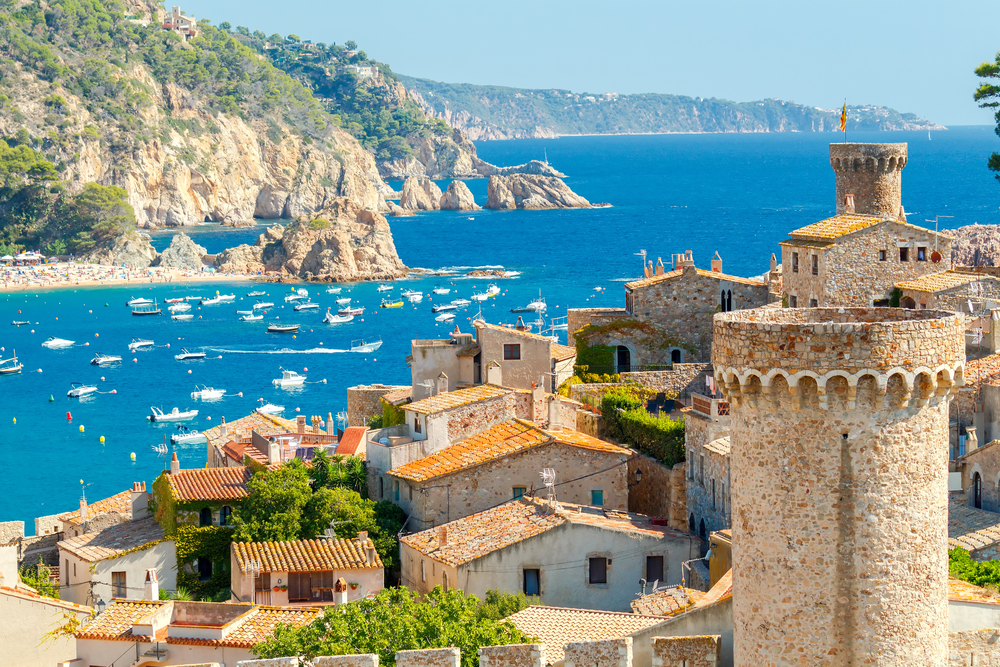
First rule: There are no rules. These resources are completely free and at your disposal. Use as much, or as little, as you want. Study casually, or work to create a portfolio of academic work that will blow the socks off of the educational establishment.
Feel free to adapt the materials for your own purposes. We expect families, business people, backpackers, college students, high school kids, middle aged vacationers, and retirees who are on a late life adventure to take these materials and run with them. We’d be very happy for teachers or travel group leaders to add these materials to their study abroad packets as well.
The nature of open source is collaboration, so please feel free to contribute when you become aware of resources we haven’t listed, or you have project ideas that we haven’t developed. Send us your work and inspire others to reach higher and deeper as they travel!
Our goal with this project is to inspire adventure and further education through experiential learning around the world. Please send us a note and let us know how you used these resources!
Buffet Style Learning
Does the menu look overwhelming? Looking for a formula to use as a skeleton for your studies in Spain?
Choose:
- Two books
- Two films
- Three articles
- One Problem & Solution or Project Option
- One Cultural Assignment
Table of Contents
- Books
- Books for Kids
- Films
- Articles
- Project Options
- Problems & Solutions
- Cultural Assignments
- Create Your Own Coursework
Book Recommendations
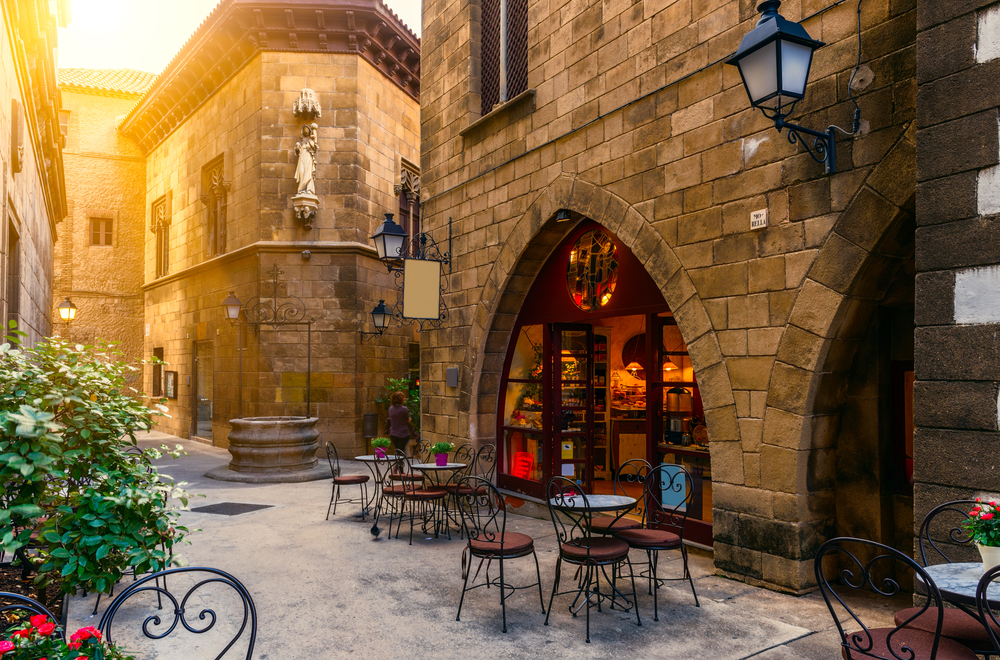
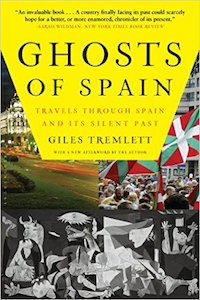 Ghosts of Spain: Travels Through Spain and Its Silent Past
Ghosts of Spain: Travels Through Spain and Its Silent Past
by Giles Tremlett
The appearance, more than sixty years after the Spanish Civil War ended, of mass graves containing victims of Francisco Franco’s death squads finally broke what Spaniards call “the pact of forgetting”-the unwritten understanding that their recent, painful past was best left unexplored.
At this charged moment, Giles Tremlett embarked on a journey around the country and through its history to discover why some of Europe’s most voluble people have kept silent so long. In elegant and passionate prose, Tremlett unveils the tinderbox of disagreements that mark the country today. Ghosts of Spain is a revelatory book about one of Europe’s most exciting countries.
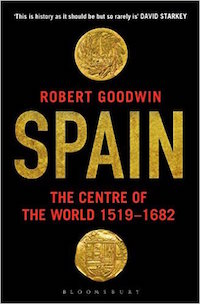 Spain: The Centre of the World 1519-1682
Spain: The Centre of the World 1519-1682
by Robert Goodwin
In the sixteenth century, the Spaniards became the first nation in history to have worldwide reach–across most of Europe to the Americas, the Philippines, and India. The Golden Age of the Spanish Empire would establish five centuries of Western supremacy across the globe and usher in an era of transatlantic exploration that eventually gave rise to the modern world. It was a time of discovery and adventure, of great political and social change–a time when Spain learned to rule the world.
It was also a time of great turbulence and transition, which fueled an exceptional flourishing of art and literature and inspired new ideas about international law, merchant banking, and economic and social theory. Chronicling the lives and achievements of a cast of legendary characters–great soldiers like the Duke of Alba, artists and writers like El Greco, Velázquez and Cervantes, and the powerful monarchs who ruled over them–Robert Goodwin delves into previously unrecorded sources to bring this tumultuous and exciting period to life. Spain is a revealing portrait of an empire at the height of its power and a world at the dawn of a new age.
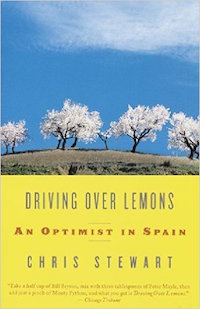 Driving Over Lemons: An Optimist in Spain
Driving Over Lemons: An Optimist in Spain
by Chis Steward
No sooner had Chris Stewart set eyes on El Valero than he handed over a check. Now all he had to do was explain to Ana, his wife that they were the proud owners of an isolated sheep farm in the Alpujarra Mountains in Southern Spain. That was the easy part.
Lush with olive, lemon, and almond groves, the farm lacks a few essentials—running water, electricity, an access road. And then there’s the problem of rapacious Pedro Romero, the previous owner who refuses to leave. A perpetual optimist, whose skill as a sheep-shearer provides an ideal entrée into his new community, Stewart also possesses an unflappable spirit that, we soon learn, nothing can diminish. Wholly enchanted by the rugged terrain of the hillside and the people they meet along the way—among them farmers, including the ever-resourceful Domingo, other expatriates and artists—Chris and Ana Stewart build an enviable life, complete with a child and dogs, in a country far from home.
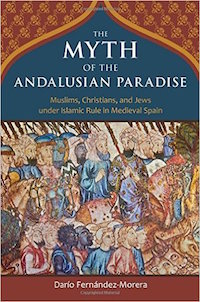 The Myth of the Andalusian Paradise: Muslims, Christians, and Jews under Islamic Rule in Medieval Spain
The Myth of the Andalusian Paradise: Muslims, Christians, and Jews under Islamic Rule in Medieval Spain
by Dario Fernandez-Morera
“An exhilarating and unput-downable read.” —Standpoint
Scholars, journalists, and even politicians uphold Muslim-ruled medieval Spain—“al-Andalus”—as a multicultural paradise, a place where Muslims, Christians, and Jews lived in harmony.
There is only one problem with this widely accepted account: it is a myth.
In this groundbreaking book, Northwestern University scholar Darío Fernández-Morera tells the full story of Islamic Spain. The Myth of the Andalusian Paradise shines light on hidden history by drawing on an abundance of primary sources that scholars have ignored, as well as archaeological evidence only recently unearthed.
This supposed beacon of peaceful coexistence began, of course, with the Islamic Caliphate’s conquest of Spain. Far from a land of religious tolerance, Islamic Spain was marked by religious and therefore cultural repression in all areas of life and the marginalization of Christians and other groups—all this in the service of social control by autocratic rulers and a class of religious authorities.
The Myth of the Andalusian Paradise provides a desperately needed reassessment of medieval Spain. As professors, politicians, and pundits continue to celebrate Islamic Spain for its “multiculturalism” and “diversity,” Fernández-Morera sets the historical record straight—showing that a politically useful myth is a myth nonetheless.
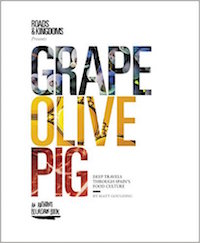 Grape, Olive, Pig: Deep Travels Through Spain’s Food Culture
Grape, Olive, Pig: Deep Travels Through Spain’s Food Culture
by Matt Goulding
Matt Goulding introduces you to the sprawling culinary and geographical landscape of his adoptive home, and offers an intimate portrait of this multifaceted country, its remarkable people, and its complex history. Fall in love with Barcelona’s tiny tapas bars and modernist culinary temples. Explore the movable feast of small plates and late nights in Madrid. Join the three-thousand-year-old hunt for Bluefin tuna off the coast of Cadiz, then continue your seafood journey north to meet three sisters who risk their lives foraging the gooseneck barnacle, one of Spain’s most treasured ingredients. Delight in some of the world’s most innovative and avant-garde edible creations in San Sebastian, and then wash them down with cider from neighboring Asturias. Sample the world’s finest acorn-fed ham in Salamanca, share in the traditions of cave-dwelling shepherds in the mountains beyond Granada, and debate what constitutes truly authentic paella in Valencia.
Grape, Olive, Pig reveals hidden gems and enduring delicacies from across this extraordinary country, contextualizing each meal with the stories behind the food in a cultural narrative complemented by stunning color photography. Whether you’ve visited Spain or have only dreamed of bellying up to its tapas bars, Grape, Olive, Pig will wake your imagination, rouse your hunger, and capture your heart.
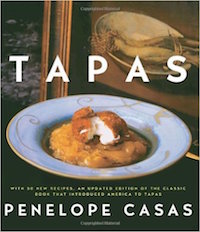 Tapas: The Little Dishes of Spain
Tapas: The Little Dishes of Spain
by Penelope Casas
Penelope Casas, who introduced the classic little dishes of Spain to American cooks more than twenty years ago, now gives us a splendid updated edition of that seminal book—with fifty exciting new recipes and eight full pages of new color photographs showing tapas in all their glory.
Here are all the appetizer dishes that have long been a tradition in Spanish cuisine—mélanges of seafood in aromatic sauces; little ragouts of meat, sausages, beans; colorful salads and marinades; the omelets called tortillas that enclose a variety of tasty tidbits; banderillas, zesty combinations on skewers; and empanadas, savory delights encased in pastry. The new recipes Casas includes reflect the influence of the innovative cooking in Spain today—dishes seasoned with soy sauce or balsamic vinegar; ingredients wrapped in flaky phyllo pastry; accents of goat cheese and arugula; foie gras in elegant presentations.
With Spanish cooking at the forefront of today’s cuisine, this “exceptional book by the leading American authority on the foods of Spain” (as Craig Claiborne dubbed it in 1985) is a must for every adventurous cook in America today.
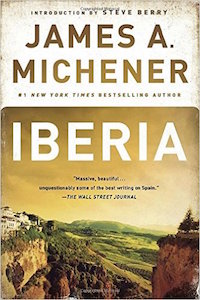 Iberia
Iberia
by James A. Michener
Spain is an immemorial land like no other, one that James A. Michener, the Pulitzer Prize–winning author and celebrated citizen of the world, came to love as his own. Iberia is Michener’s enduring nonfiction tribute to his cherished second home.
In the fresh and vivid prose that is his trademark, he not only reveals the celebrated history of bullfighters and warrior kings, painters and processions, cathedrals and olive orchards, he also shares the intimate, often hidden country he came to know, where the congeniality of living souls is thrust against the dark weight of history. Wild, contradictory, passionately beautiful, this is Spain as experienced by a master writer.
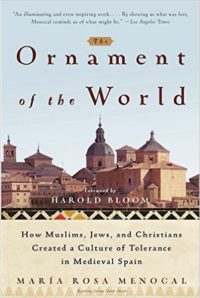 The Ornament of the World: How Muslims, Jews and Christians Created a Culture of Tolerance in Medieval Spain
The Ornament of the World: How Muslims, Jews and Christians Created a Culture of Tolerance in Medieval Spain
by Maria Rosa Menocal
María Rosa Menocal’s wafting, ineffably sad The Ornament of the World tells of a time and place–from 786 to 1492, in Andalucía, Spain–that is largely and unjustly overshadowed in most historical chronicles. It was a time when three cultures–Judaic, Islamic, and Christian–forged a relatively stable (though occasionally contentious) coexistence. Such was this period that there remains in Toledo a church with an “homage to Arabic writing on its walls [and] a sumptuous 14th-century synagogue built to look like Granada’s Alhambra.” Long gone, however, is the Córdoba library–a thousand times larger than any other in Christian Europe.
Menocal’s history is one of palatine cities, of philosophers, of poets whose work inspired Chaucer and Boccaccio, of weeping fountains, breezy courtyards, and a long-running tolerance “profoundly rooted in the cultivation of the complexities, charms and challenges of contradictions,” which ended with the repression of Judaism and Islam the same year Columbus sailed to the New World. –H. O’Billovich
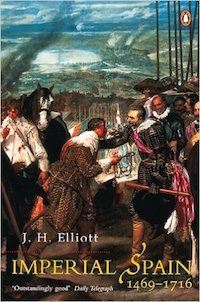 Imperial Spain: 1469-1716
Imperial Spain: 1469-1716
by J. H. Elliott
Since its first publication, J. H. Elliott’s classic chronicle has become established as the most comprehensive, balanced, and accessible account of the dramatic rise and fall of imperial Spain. Now with a new preface by the author, this brilliant study unveils how a barren, impoverished, and isolated country became the greatest power on earth—and just as quickly fell into decline.
At its greatest Spain was a master of Europe: its government was respected, its armies were feared, and its conquistadores carved out a vast empire. Yet this splendid power was rapidly to lose its impetus and creative dynamism. How did this happen in such a short space of time? Taking in rebellions, religious conflict and financial disaster, Elliott’s masterly social and economic analysis studies the various factors that precipitated the end of an empire.
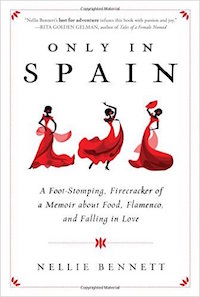 Only in Spain: A Foot-Stomping, Firecracker of a Memoir about Food, Flamenco, and Falling in Love
Only in Spain: A Foot-Stomping, Firecracker of a Memoir about Food, Flamenco, and Falling in Love
by Nellie Bennett
Ten-hour shifts in a high-end department store and catering to snooty customers… Nellie Bennett’s life wasn’t supposed to turn out this way. But maybe all she needs to do is infuse a little passion into her routine?through flamenco dance lessons, for instance.
What Nellie doesn’t realize is that flamenco is not just a dance?it’s a way of life that seems much more enticing than her depressing retail gig. So she packs her suede dance shoes and leaves everything she knows behind, flying halfway around the world to seek the authentic experience in Seville, where the dark-eyed gypsy boys and mouth-watering tapas are enough to make Nellie want to stay in Spain forever. And why shouldn’t she?
Only in Spain is a foot-stomping, full-on firecracker of a memoir?crackling with energy, food, dance, gypsies, and love?that will capture your heart with the first “Olé!”
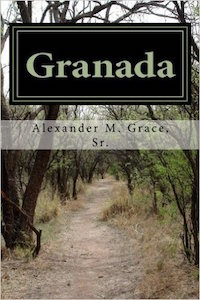 Granada: A Novel of Moorish Spain
Granada: A Novel of Moorish Spain
by Alexander M. Grace Sr.
Granada is a novel set in Spain at the end of the 15th Century. The kingdom of Granada was the last remnant of the Moorish empire in Spain that was gradually being crushed by the armies of the resurgent Christians from the North. At the same time, Granada was the last remnant of the Golden Age of Moslem enlightenment, a culture of religious toleration, intellectual achievement, and scientific study.
Into the maelstrom of war are thrown three very different characters, a young Jewish woman whose family has been forced to pretend to convert to Christianity and who is now the target of the Spanish Inquisition, a Moorish intellectual who only wants peace and quiet to study and think, and a brutal Spanish knight, poor but ambitious, with a very dark secret. As the kingdom crumbles, they will struggle to survive both the war and each other.
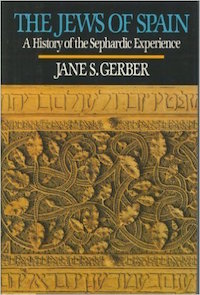 The Jews of Spain: A History of the Sephardic Experience
The Jews of Spain: A History of the Sephardic Experience
by Jane S. Gerber
Sephardic Jews form one of the two mainstreams of Jewish life – it was they who founded the first Jewish settlements in America, and they played an important role in colonial society. That history has been obscured by the subsequent arrival of German and Russian Jews whose greater numbers have dominated the American Jewish community for over a century. But the diaspora of Spanish Jews is older, and their longing for the vanished land of “Sepharad”, their homeland for a 1000 years, provides one of the greatest themes in Jewish history.
Now historian Jane Gerber for the first time traces their great story – rich in both events and personalities – from its ancient beginnings in Roman Iberia to the present day. Gerber shows how the Jews created a civilization in Spain that was both Jewish and secular long before the enlightened Age of Emancipation. Sephardic Jews achieved remarkable success within their “host” society, distinguishing themselves as theologians and philosophers, writers and artists, businessmen, courtiers, and medical men. This rich legacy of culture and accomplishment has inspired a just pride in Sephardic Jews that persists to this day; the Sephardic experience also sheds light on the possibilities for peaceful coexistence among Christians, Jews, and Arabs.
The expulsion of the Jews from Spain in 1492 thus has a special pathos as the story of the wanton destruction of a flourishing community with roots going back a millennium or more. The book should also be a timely addition to the worldwide observances of the events of 1492 on their 500th anniversary.
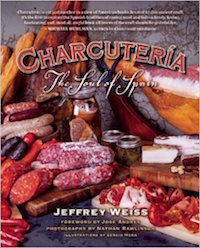 Charcutería: The Soul of Spain
Charcutería: The Soul of Spain
by Jeffrey Weiss
Charcutería: The Soul of Spain is the first book to introduce authentic Spanish butchering and meat-curing techniques to America. Included are more than 100 traditional Spanish recipes, straightforward illustrations providing easy-to-follow steps for amateur and professional butchers, and gorgeous full-color photography of savory dishes, Iberian countrysides, and centuries-old Spanish cityscapes.
Jeffrey Weiss has written an entertaining, extravagantly detailed guide on Spanish charcuterie, which is deservedly becoming more celebrated on the global stage. While Spain stands cheek-to-jowl with other great cured-meat-producing nations like Italy and France, the unique charcuterie traditions of Spain are perhaps the least understood of this trifecta. Americans have most likely never tasted the sheer eye-rolling deliciousness that is cured Spanish meats: chorizo, the garlic-and-pimentón-spiked ambassador of Spanish cuisine; morcilla, the family of blood sausages flavoring regional cuisine from Barcelona to Badajoz; and jamón, the acorn-scented, modern-day crown jewel of Spain’s charcutería legacy.
Charcutería is a collection of delicious recipes, uproarious anecdotes, and time-honored Spanish cuisine and culinary traditions. The author has amassed years of experience working with the cured meat traditions of Spain, and this book will surely become a standard guide for both professional and home cooks.
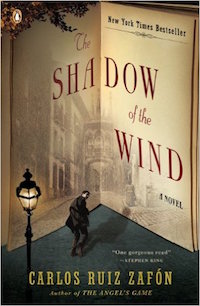 The Shadow of the Wind
The Shadow of the Wind
by Carlos Ruiz Zafón
Barcelona, 1945: A city slowly heals in the aftermath of the Spanish Civil War, and Daniel, an antiquarian book dealer’s son who mourns the loss of his mother, finds solace in a mysterious book entitled The Shadow of the Wind, by one Julián Carax. But when he sets out to find the author’s other works, he makes a shocking discovery: someone has been systematically destroying every copy of every book Carax has written. In fact, Daniel may have the last of Carax’s books in existence. Soon Daniel’s seemingly innocent quest opens a door into one of Barcelona’s darkest secrets–an epic story of murder, madness, and doomed love.
“ Anyone who enjoys novels that are scary, erotic, touching, tragic and thrilling should rush right out to the nearest bookstore and pick up The Shadow of the Wind. Really, you should.” –Michael Dirda, The Washington Post
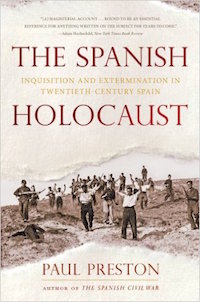 The Spanish Holocaust: Inquisition and Extermination in Twentieth-Century Spain
The Spanish Holocaust: Inquisition and Extermination in Twentieth-Century Spain
by Paul Preston
Long neglected by European historians, the unspeakable atrocities of Franco’s Spain are finally brought to tragic light in this definitive work.
Evoking such classics as Anne Applebaum’s Gulag and Robert Conquest’s The Great Terror, The Spanish Holocaust sheds light on one of the darkest and most unexamined eras of modern European history.
As Spain finally reclaims its historical memory, a full picture can now be drawn of the atrocities of Franco’s Spain—from torture and judicia
l murders to the abuse of women and children. Paul Preston provides an unforgettable account of the systematic terror carried out by Spain’s fascist government. 16 pages of illustrations.
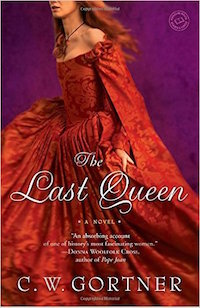 The Last Queen: A Novel
The Last Queen: A Novel
by C. W. Gortner
In this stunning novel, C. W. Gortner brings to life Juana of Castile, the third child of Queen Isabel and King Ferdinand of Spain, who would become the last queen of Spanish blood to inherit her country’s throne. Along the way, Gortner takes the reader from the somber majesty of Spain to the glittering and lethal courts of Flanders, France, and Tudor England.
Born amid her parents’ ruthless struggle to unify and strengthen their kingdom, Juana, at the age of sixteen, is sent to wed Philip, heir to the Habsburg Empire. Juana finds unexpected love and passion with her dashing young husband, and at first she is content with her children and her married life. But when tragedy strikes and she becomes heir to the Spanish throne, Juana finds herself plunged into a battle for power against her husband that grows to involve the major monarchs of Europe. Besieged by foes on all sides, Juana vows to secure her crown and save Spain from ruin, even if it costs her everything.
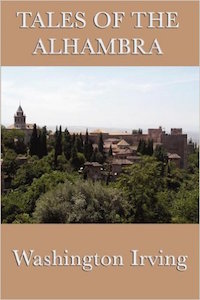 Tales of the Alhambra
Tales of the Alhambra
by Washington Irving
The Alhambra: a series of tales and sketches of the Moors and Spaniards was published in May 1832, Consisting of a series of essays and short fiction pieces, it was referred to as his “Spanish Sketch Book.” In 1851 Irving wrote the “Author’s Revised Edition”, also titled Tales of the Alhambra. Tales of the Alhambra is a collection of essays, verbal sketches, and stories.
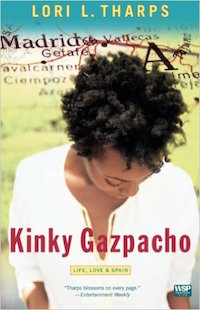 Kinky Gazpacho: Life, Love & Spain
Kinky Gazpacho: Life, Love & Spain
by Lori Tharps
Magazine writer and editor Lori Tharps was born and raised in the comfortable but mostly White suburbs of Milwaukee, Wisconsin, where she was often the only person of color in her school and neighborhood. At an early age, Lori decided that her destiny would be discovered in Spain. She didn’t know anyone from Spain, had never visited the country, and hardly spoke the language. Still, she never faltered in her plans to escape to the Iberian Peninsula.
Arriving in the country as an optimistic college student, however, Lori soon discovers Spain’s particular attitude toward Blackness. She is chased down the street by the local schoolchildren and pointed at incessantly in public, and her innocent dreams of a place where race doesn’t matter are shattered. The story would end there, except Lori meets and marries a Spaniard, and that’s when her true Spanish adventure really begins.
Against the ancient backdrops of Cádiz and Andalucía, Lori starts the intricate yet amusing journey of rekindling her love affair with Spain and becoming a part of her new Spanish family. From a grandmother who spies on her to a grandfather who warmly welcomes her to town with a slew of racist jokes, the close-knit clan isn’t exactly waiting with open arms. Kinky Gazpacho tells the story of the redeeming power of love and finding self in the most unexpected places.
At its heart, this is a love story. It is a memoir, a travel essay, and a glimpse into the past and present of Spain. As humorous and entertaining as such favorite travel stories as Under the Tuscan Sun, this book also unveils a unique and untold history of Spain’s enduring connection to West Africa. Kinky Gazpacho celebrates the mysticism of travel and the joys of watching two distinct cultures connect and come together.
Kids Book Recommendations
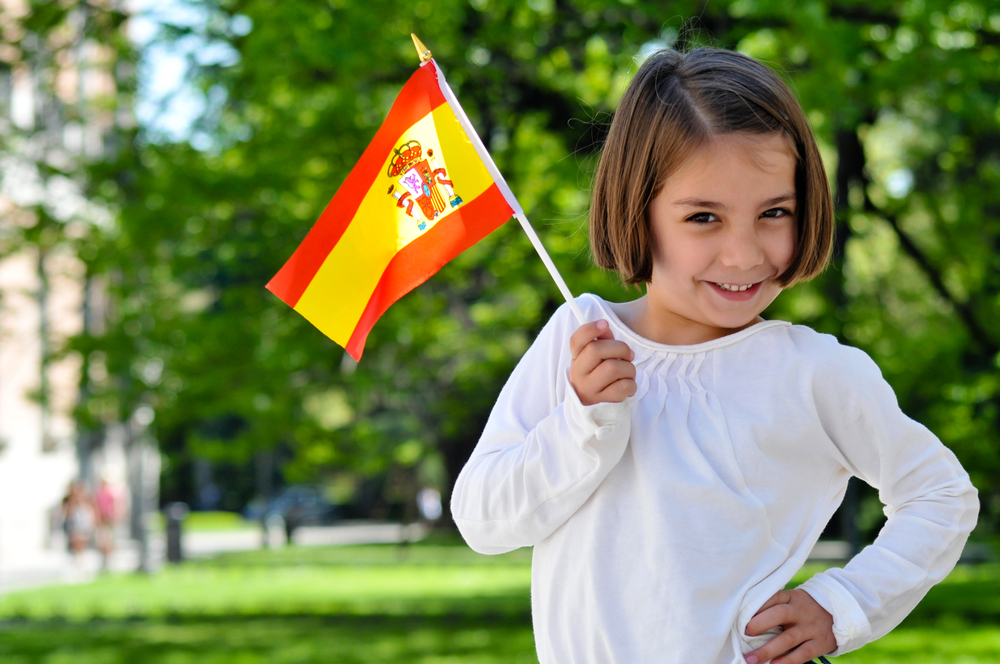
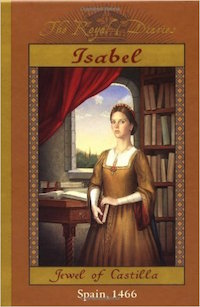 Isabel: Jewel of Castilla, Spain 1466 (The Royal Diaries)
Isabel: Jewel of Castilla, Spain 1466 (The Royal Diaries)
by Carolyn Meyer
This fictional diary of Queen Isabel of Spain begins when she is a lonely fifteen-year-old princess, forced by her brother, King Enrique, to live away from her widowed mother. She plots to bring her other brother, Alfonso, to the throne, while thwarting her brother’s attempts to arrange a marriage for her. She decides to take matters into her own hands and arrange a marraige that will bring her happiness and political prosperity. This was a wonderful book that brought Isabel to life, not just as a royal figure, but as a teenager with feelings and dreams. I highly reccomend this to historical fiction fans, especially if you enjoyed other books in the Royal Diaries series. – Rebecca Herman
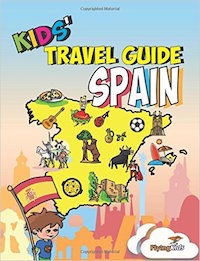 Kids’ Travel Guide – Spain: The fun way to discover Spain – especially for kids
Kids’ Travel Guide – Spain: The fun way to discover Spain – especially for kids
by Wendy Crawford & Shiela H. Leon
Barcelona, Madrid, Seville … Whichever city or part of Spain your family plans to visit, make sure you have the Kids’ Travel Guide — Spain. A unique travel guide and activity book in one, it’s the fun way to discover Spain!
All about Spain, especially for kids—geography, fascinating history, and flags and symbols, as well as Spanish culture, food, and even some useful word in Spanish.
Fun, educational, and engaging—Leonardo, your kids’ tour guide, will take them on a journey through Spain and keep them interested with fun facts, “juicy information,” quizzes, special tasks, coloring pages, and their own travel diary.
A bonus for parents—As a parent, you are invited to participate in your children’s activities or to find an available bench and relax while your kids learn and enjoy.
A personal book that becomes your children’s souvenir of the trip—When you return home, the guidebook and diary will become a memoir of your Spanish vacation that the whole family can treasure for a lifetime.
Now available for e-book readers too! Kids’ Travel Guide — Spain is an interactive travel book that includes quizzes, tasks, coloring pages, a travel diary, and much more. While the print edition provides the most complete experience, you can now combine it with the e-book to engage kids fully. Take advantage of this special offer: Download the e-book FREE with the purchase of the print edition!
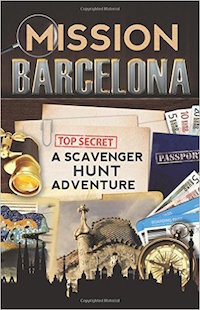 Mission Barcelona: A Scavenger Hunt Adventure
Mission Barcelona: A Scavenger Hunt Adventure
by Catherine Aragon
Mission Barcelona takes your young travelers through the famous sights of Barcelona, engaging them in an exciting scavenger hunt as you explore city landmarks together.
Say ‘adiós’ to a trip filled with the stress of keeping everyone entertained. Instead, say ‘hola!’ to a memorable family vacation. Imagine – your kids will be excited to sightsee as you discover the wonders of Barcelona as a family.
Get Mission Barcelona today for your young jet-setters…and make sure it’s in their bag when they take off for Spain!
Mission Barcelona offers a fun vacation for everyone – with a captivating, spy-theme scavenger hunt packed with entertaining activities.
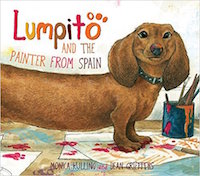 Lumpito and the Painter from Spain
Lumpito and the Painter from Spain
by Monica Kulling
Lump the dachshund is content living with David in Italy. But he needs a vacation from Big Dog, who hounds him day and night. So when David announces that he’s off to the south of France to photograph a famous painter, Lump positively scrambles at the chance to ride along. At the villa, Pablo Picasso greets them and is enchanted with the little dog he calls Lumpito. The feeling is mutual; from that moment on, the two become soul mates. Lump loves David. But how can he show his master, and Picasso, that he is home at last?
Lumpito and the Painter from Spain is inspired by the true story of Picasso’s love affair with a dachshund named Lump who came for a visit, refused to leave and became immortalized in a number of the artist’s paintings and drawings.
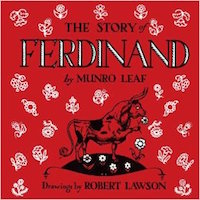 The Story of Ferdinand
The Story of Ferdinand
by Munro Leaf
Ferdinand is the world’s most peaceful–and–beloved little bull. While all of the other bulls snort, leap, and butt their heads, Ferdinand is content to just sit and smell the flowers under his favorite cork tree.
Leaf’s simple storytelling paired with Lawson’s pen-and-ink drawings make The Story of Ferdinand a true classic. Commemorate the 75th anniversary of the book’s original publication with this beautiful and affordable 8×8 paperback edition.
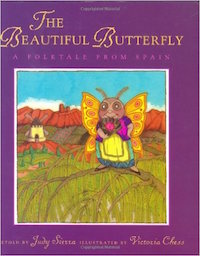 The Beautiful Butterfly: A Folktale from Spain
The Beautiful Butterfly: A Folktale from Spain
by Judy Sierra
A beautiful butterfly is courted by many suitors. She finally finds a husband who has a singing voice soft and sweet enough to please her, but no sooner does the honeymoon begin than he is swallowed by a giant fish!
All of nature joins her in mourning, setting off a comical chain of events that results in a second chance for the beautiful butterfly and her devoted husband. Enchantingly original depictions of the beautiful butterfly and her friends and an inventive happy ending reveal the sweetness and humor of this enduring Spanish folktale.
Film Recommendations
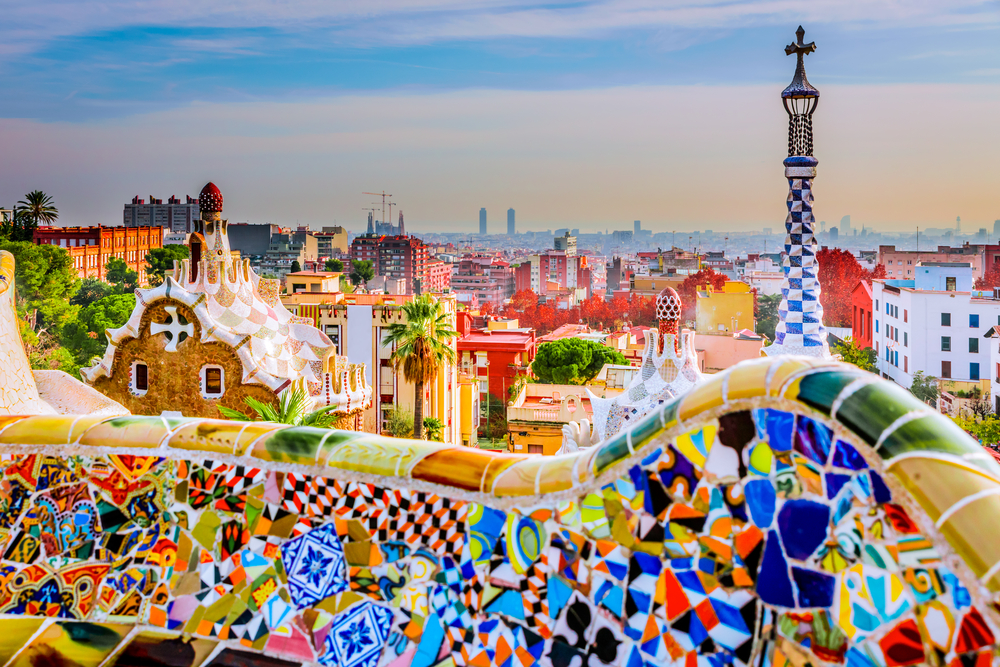
When the Moors (Muslims) Ruled Europe: Documentary
Spanish Inquisition Documentary
Human Trafficking & Unregulated Prostitution: Spain’s Sex Supermarket
When it comes to sex work, Spain is in a state of flux. Unspecific laws on prostitution and open European borders have led to a huge stream of migrant women forced into sex work as they attempt to relocate into the country. At the same time, Spain’s economic problems have stirred a growing number of women to take charge of the situation and willingly turn their bodies into a business. Traveling across the country, Spain’s Sex Supermarket highlights the current state of play, speaking to people who work across the sex industry–from the women behind Spain’s first union for prostitutes, to prostitution workshops lead by Spain’s highest paid escort Paula VIP. We also speak to migrant women from Eastern Europe, who have crossed many borders either by force or to take advantage of an insatiable demand in a country where 39% of men have admitted to paying for sex at least once in their lives.
From the beaches of Barcelona, to the nightclubs of Ibiza, to a small town on the border of France where human trafficking has run amok, Broadly explores what happens when sex work goes unregulated and asks what can be done to fix it.
Brief History of the Spanish Royal Family
The Spanish Royal Family from 1469 to today.
Walls of Shame – Fortress Europe: The Spanish-Moroccan border
The city of Ceuta is the southernmost outpost of fortress Europe. Yet it is on mainland Africa – opposite the Straights of Gibraltar. It is one of the last vestiges of Spanish rule in northern Morocco.
Madrid insists it will never relinquish control and has cordoned it off – prompting comparison with other walls of shame.
ECONOMY / SPAIN: Youth unemployment higher than fifty percent
RUNNING OF THE BULLS PAMPLONA SPAIN
We travel to Pamplona, Spain to witness the most legendary fiesta on earth – the “Running of the Bulls,” known locally as la Fiesta de San Fermín. We dive into the party, run with the toros and explore the more controversial side of the festival.
The Spanish Empire, Silver, & Runaway Inflation: Crash Course World History #25
In which John Green explores how Spain went from being a middling European power to one of the most powerful empires on Earth, thanks to their plunder of the New World in the 16th and 17th centuries. Learn how Spain managed to destroy the two biggest pre-Columbian civilizations, mine a mountain made of silver, mishandle their economy, and lose it all by the mid-1700s. Come along for the roller coaster ride with Charles I (he was also Charles V), Philip II, Atahualpa, Moctezuma, Hernán Cortés, and Francisco Pizarro as Spain rises and falls, and takes two empires and China down with them.
Goya: The Most Spanish of Artists
Francisco Goya’s paintings, drawings, and prints reveal a universal human experience as well as that which is uniquely Spanish. Gain an insider’s knowledge of the exhibition “Goya: Order and Disorder” with its curators Frederick Ilchman, chair, Art of Europe, and Mrs. Russell W. Baker Curator of Paintings; and Stephanie Stepanek, curator, Prints and Drawings.
The Way Trailer – Official Trailer & Martin Sheen and Emilio Estevez Exclusive Interview
Our video presentation exploring the history of Women’s rights in Spain.
The World’s Strangest Borders Part 2: Spain
There are some really weird borders in the world, and Spain is probably the cause of some of the strangest.
Article Recommendations
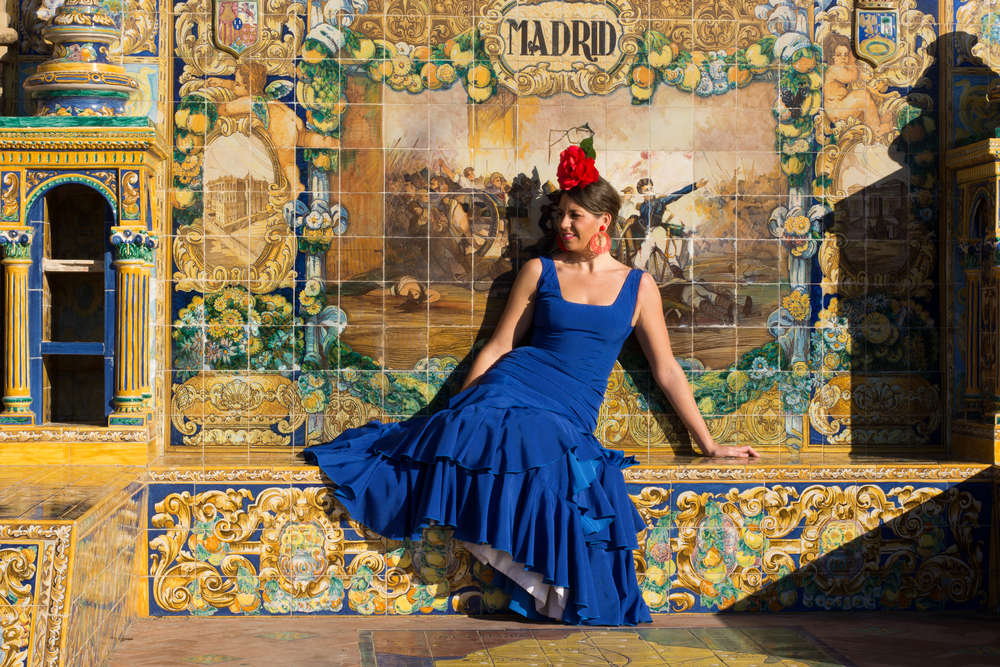
Retrieving an Untold Story: Voices of Spanish Female Artists Finally Heard – The Guardian
Spain’s Monarchy Drawn into Banking Scandal – The Economist
Hundreds of African Refugees Storm Spain’s Killer Fence – Al Jazeera
Spain’s Economy Back on it’s Feet – Economist
Barcelona Marches to Curb Negative Effects of Tourism Boom – The Guardian
Gender Issues in Spain – West
Does Bullfighting Have a Future in Spain? – Al Jazeera
Time to Wake Up! Spain’s Prime Minister Wants to End the Siesta – Washington Post
Gender Inequality in Spain: Glass Ceiling or Steel Barrier? – Open Democracy
Madrid Bans Half of Cars from Roads to Fight Air Pollution – The Guardian
Working 9 to 8: Spain Seeks to Shorten 11-Hour Working Day – The Guardian
Gender Pay Gap in Spain Widens to 24 Percent – Sur in English
Could Spain help fix Europe? – Washington Post
Spain’s Drought Reveals Lost Worlds – Al Jazeera
Spain Shown Perils of Climate Change -The Guardian
The End of JuanCarlismo – The Economist
The Challenge of Climate Change in Spain: Water Resources, Agriculture and Land – Science Direct
Refugees along the Spanish-Moroccan Border – Spiegel
Project Options:
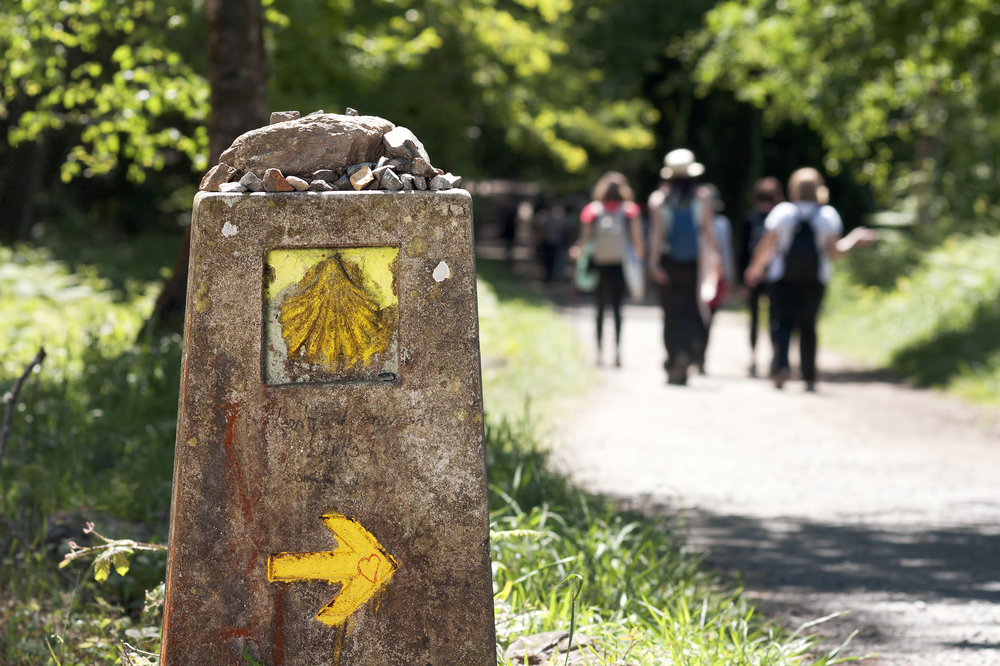
History
Spain has a long and rich history, fraught with conflict and conquest from the earliest times. The rise and fall of various powers in the region has had far reaching consequences around the globe. Spend some time studying the arc of Spanish history, or dive deep into on particular area of interest.
- First people to migrate into Spain
- Pre-Roman powers in Spain
- Spain under Roman rule
- Goths in Spain
- Moors in Spain
- Spain under the Habsburgs
- Spanish Golden Age
- Spain under the Bourbons
- The Spanish Conquistadors & the Colonial Era
- Spanish War of Independence
- Establishment of the Spanish Republic (first and second- compare & contrast)
- Spanish Civil War
- Franco Dictatorship
- Spain as part of the European community (modern)
Spanish Monarchy
The Spanish tradition of monarchy dates back to the Visgoth period and has been volatile, by times. After being abolished, Spain’s new constitution in 1978 reinstated the political structure of a Constitutional Monarchy.
Who is the King of Spain now? What is his role in the government? How much does the Spanish government allocate for the maintenance of the monarchy, and how does this compare with other constitutional monarchies in Europe? Is the monarchy popular in Spain, why or why not? What are some of the problems facing the royal family and the Spanish government moving forward?
Looking backward, pick one monarch of Spain and do a mini biography on that person. What were their major accomplishments and struggles? How did they come to power? What happened in Spain during their reigns? What are they most known for? What is important but little known about them?
Camino de Santiago
The Camino de Santiago is not one path, but a network of footpaths that crisscross Europe all ending in Santiago de Compostella, on the western edge of Spain. Traditionally, this has been a Catholic pilgrimage, but it actually predates Catholicism and has its roots in Druidic pilgrimage.
Which is the most commonly walked path in Spain? Why is the Camino de Santiago significant to Catholics? To secular people? Learn some of the history of the pilgrimage. Walk part of the Camino de Santiago while you are in Spain, if not all of it.
Watch the movie The Way with Martin Sheen (trailer above) to get a feel for the Camino.
Artists of Spain
Spain has been a hot bed of art for centuries. Take some time to visit the big art museums in Madrid, Valencia & Barcelona. Pay special attention to the Spanish artists. Spend some time learning about the life, influences, and art of some of the greats.
Here is a partial list to get you started:
- Valazquez
- Ortiz
- Gaudi
- Echevarría
- Picasso
- Miró
- Dalí
- Arroyo
- Muñoz
- Barceló
Flamenco
A blend of singing, dancing, and guitar music that gets at the heart is the essence of Flamenco. Each of the three arts, which grew collectively out of gypsy interest and culture in southern Spain, can stand alone, but the combination of the three is what embodies classic Flamenco.
When and how did Flamenco emerge? Who were/are the greats in each of the three components? How is modern guitar flamenco continuing to evolve? Go and see a Flamenco performance, and perhaps take a dance or singing lesson.
Profiles of …..
Conduct a series of at least five interviews within a country. The point of the exercise would be to get a well rounded view of what it is like to live in the France from a variety of ages, incomes, employments and experiences. This could be conducted as video, or as text. Do an in depth analysis of the experience/information.
People you might profile:
- Farmers
- Teachers
- Restaurant owners/workers
- Clergy or Nuns
- Government officials
- Doctors or nurses
- Cafe owners
- Street vendors
- Children
- Parents
- Drivers
- Artists or musicians
- Laborers
- Cab drivers
- Long term expats
Problems & Solutions
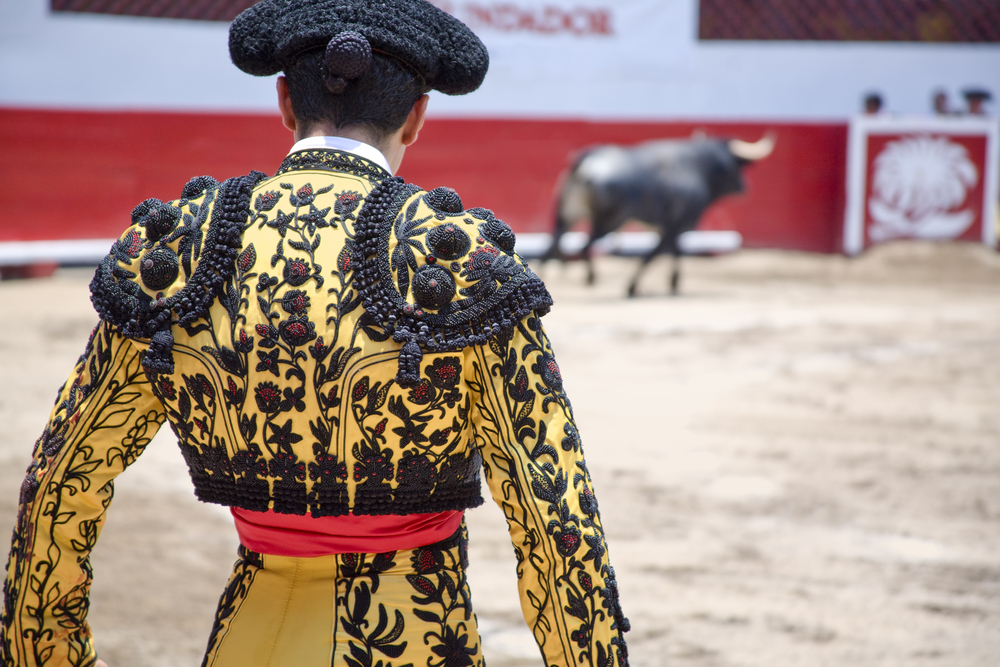
Economy
The economic collapse of 2008 ended a ten year span of optimistic economic growth for Spain. Since then the economy has struggled and floundered. Why? What is the national economy like? What are the major sources of revenue for the nation? What is the unemployment rate? Is it rising or falling?
What is the government, both regionally and nationally doing to boost the economy? Where are they seeing success? Where are there still struggles? Do some interviews with Spanish people you meet and ask, specifically, about their experiences through the cycle of growth in the early millennium and the subsequent crash and reconstruction.
What is life like for the average Spanish family in the current economy? Do they feel better off than five years ago? Or worse? What are their individual factors?
Immigration & Refugees
Spain, like much of the rest of Europe, struggles with immigration and the influx of refugees. Particularly along their border with Morocco. What is the position of the Spanish government on immigration and refugees? What is the experience of refugees trying to get into Spain?
Ask questions and try to really listen to both sides of this complex issue. Compare and contrast the view points of Spanish nationals and immigrants, both legal and illegal. Who is Spain welcoming to the country? Who are they actively keeping out? Why? How does the EU policy around immigration and refugee status affect Spain’s policy and the experience of refugees using Spain as a point of entry to the EU?
Are there refugee camps in Spain like there are in other parts of Europe? If so, where are these and what are they like?
Climate Change
As a nation that is bordered by the sea on three sides, climate change and sea levels rising as a result pose a significant risk to a large portion of Spain. However sea level change is not the only aspect of climate change that is going to affect Spain. Already there are impacts.
How is Spain already experiencing climate change? What are the projected impacts in coming years if the trend is not abated. What is the policy of the Spanish government regarding the initiatives to reduce human impact?
Prostitution
In most of Europe prostitution is either illegal, or it’s legal and regulated. Spain presents an interesting grey area in which prostitution is neither illegal, nor regulated. This has created a situation in which an influx of women from poorer eastern European countries flock to engage in prostitution with few laws to inhibit, or protect them.
Learn more about prostitution in Spain and why the lack of laws is the way it is. Why is the government reticent to regulate the industry? What is the situation for women who engage in prostitution? Are there any NGOs seeking to provide services or assistance to these women?
If possible, delve deeper into the female culture of prostitution in Spain and ask some questions. Why do women come here? What do they gain? Why does this industry seem like the best career choice for them at this point? How has prostitution been featured in the news and in political discussions in Spain?
Cultural Assignment Options
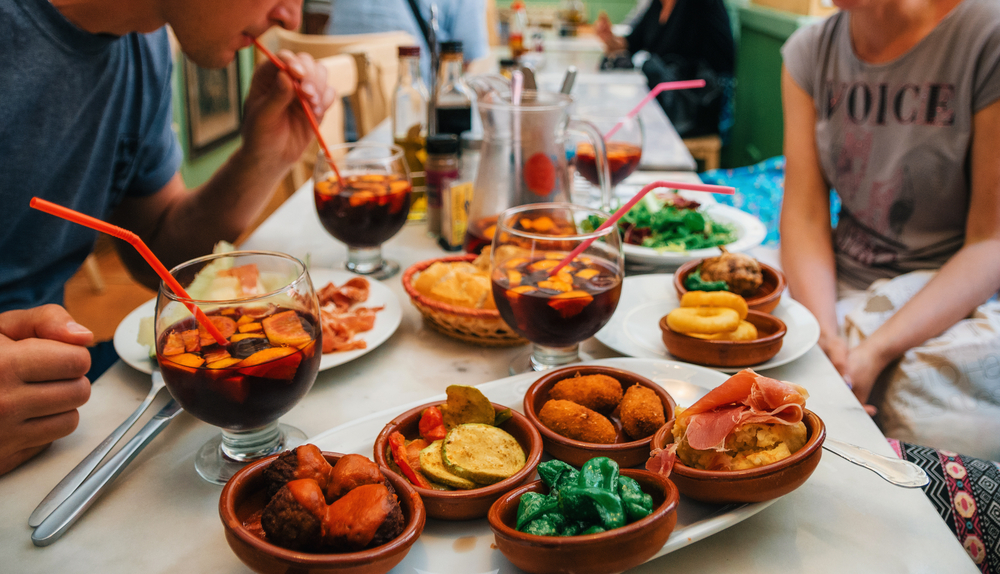
Food
Spain has a fantastic food culture. Every region rich with its own delicacies and versions of tapas or pinchos. Be sure to eat everything. From duck in the Basque regions to pulpo on the coast, to the fabulously artful paellas. Bocadillos and cured meat bites of every possible combination grace afternoon plates.
Eat your way around Spain. Don’t miss a mouthful. And be sure to pair it all with local wines. The vino tinto of every little town should be savored.
Make a record (or a video!) of all of the new foods you’re trying as you travel through Spain.
Meaningful Connections
What is a meaningful interaction? You get to decide that. In general, it should be an interaction in which cultural exchange took place and you learned something. Often this will be with a local person; sometimes it will be with another traveler.
Sometimes these interactions look like very little on the outside but are totally life changing on the inside. Other times, they are rock your world amazing from every angle. It could be a meal shared, an afternoon’s excursion, a discussion that opens your eyes in some way, a self revelation that happened without any words exchanged at all.
Spend a day with a local individual or family. Document your experience in photos, interviews and the written word. The best way to interact with locals is to just start chatting with them at markets, on tours or on the street. You can also ask other travelers if they have met anyone who has offered some insight into life in the country. If you are a family who have children attending a local school then have a party, invite a parent to coffee, basically just open up your home to new relationships.
Take a Class
There are many options! Don’t be limited by this list:
- Cooking
- Language
- Art or Crafts
- Flamenco/li>
- Literature
- Yoga
- Painting or Sculpture
Museum Visits
Spain’s rich history and wide colonial reach has made for some spectacular museums around the country. Take time to explore the small ones as well as the bigger ones. Spend some time in the cathedrals as well, which are museums in and of themselves, often. (Always ask, because, often, the bigger cathedrals have separate museums associated with them that aren’t always well advertised.)
In my opinion, some of the most interesting include:
- Madrid Museums
- Barcelona Museums
- Leon Museum
- Valencia Museums
- Pamplona Museums
- Santiago de Compostela Museums
- Burgos Museums
Save your ticket stubs!
Volunteer
Volunteering is a great way to get to know a local community and give back a bit to the places that you choose to travel. There are lots of ways to do this, both organized and arranged privately, as well as impromptu opportunities that will pop up.
If you’re looking for a list of volunteer opportunities in Spain, Transitions Abroad has a site dedicated to helping you find one. Please be advised that TAP is not recommending these, only presenting them as a list of possibilities. Vet your volunteer options carefully.
Live local
Get out of the hostel, rent a place in a local village, or do a homestay. Through websites like Airbnb it’s easy to find places to live locally. Consider a co-living space to develop community with like minded travelers while diving a little deeper and going a little bit more local. Co-Living, has 16 options across Spain to get you started.
Photo essay or a blog description of why living local was different than living in a hostel. How did this experience change the economics of your stay? What did you learn about the way locals live? What challenged you? What would you do differently next time?
Work Stay
Through an organization like WWOOF, HelpX, or Workaway you can arrange for an opportunity to work in exchange for your room and board in a number of capacities, from farm labour to hospitality. Lots of students make use of these experiences to lower the cost of their travels, while at the same time learning valuable skills or “trying out” various career areas that interest them.
Request feedback in the form of a short evaluation that can be used later for a CV or reference
Public Transportation Project
Take as many types of public transportation as possible.
Challenge yourself to take every type of public transportation available while you are in Spain. Create a photo essay or videologue of your adventures. What did you learn?
Attend a Religious Observance
Spain is a religiously complex country with a heavy Catholic influence. However there have been periods of time when Islam was the dominant religion in the region. And, there are a range of other minor religious influences, including Jewish, traditionally. This makes for an interesting faith landscape, both historically and in the modern era. Take some time to attend various religious observances and see what you can learn. Don’t be afraid to ask questions. How does the religious climate in Australia compare with what you grew up with?
How to Create Your Own Course Work
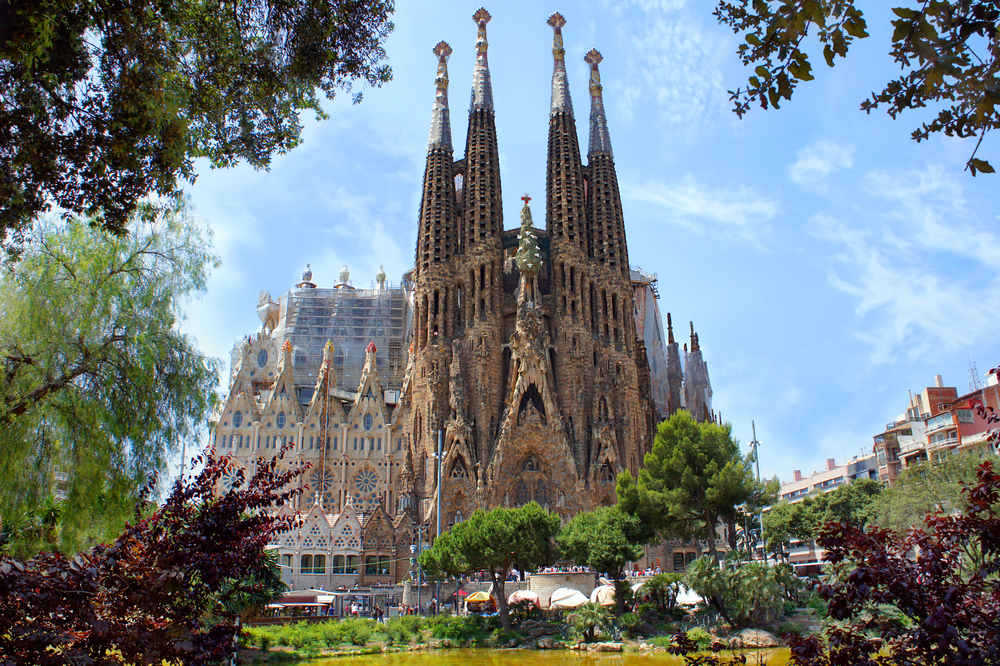
Ask
Learn to ask for what you want. If you meet someone interesting, ask them to teach you. Ask them for an interview. Ask to shadow them for a day or a week. You’ll be surprised at how eager people are to share what they know and teach when someone shows actual interest. Learn to ask questions. Learn to take social risks by putting yourself out there as a learner.
Plan
You have an idea or an interest. Something surprises you on your journey and all of a sudden you have a burning desire to know more. Plan your attack:
- Narrow your field of study to a particular question or topic.
- Compile resources: Look for teachers. Who knows what you need to know? Or who can you interview to learn more? Are there books or videos on the topic you’re interested in?
- Quantify it. How will you demonstrate what you have learned? A research paper, a video project, a photo essay, through art or music, a blog post, a published piece, an interview series, a mini documentary or do you have some other idea?
Produce
Produce a quality piece of academic work that reflects your experiential learning. The whole key to quantifying outside the box learning is to translate it into something that reflects the value of what you learned and how it contributed to your overall educational process.
Perhaps this will be as simple as a traditional research paper, depending on the depth and length of your study this could be as short as three pages or as long as a dissertation. Maybe you’ll produce a video for YouTube, or something grander, like a mini-documentary. Perhaps you’ll do something concrete instead, an art, or community action project and you’ll tell the story through a photo essay, or a series of blog posts. The possibilities are limited only by the resources you have at hand. Get creative. Think outside the box and truly experience your education.
Do You Have Anything to Add to This Resource Page?
We’re actively seeking to grow these resources in an open-source spirit. Please email jenn(at)bootsnall(dot)com with your edits or submissions of new information or materials.
Thank you!
